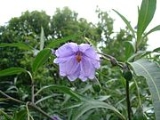
Poroporo
Encyclopedia
- "Kangaroo Apple" redirects here. This name is also used for related species of SolanumSolanumSolanum, the nightshades, horsenettles and relatives, is a large and diverse genus of annual and perennial plants. They grow as forbs, vines, subshrubs, shrubs, and small trees, and often have attractive fruit and flowers. Many formerly independent genera like Lycopersicon or Cyphomandra are...
.
Solanum aviculare, commonly called Poroporo (New Zealand) or Kangaroo Apple (Australia), is a soft-wooded shrub native to New Zealand
New Zealand
New Zealand is an island country in the south-western Pacific Ocean comprising two main landmasses and numerous smaller islands. The country is situated some east of Australia across the Tasman Sea, and roughly south of the Pacific island nations of New Caledonia, Fiji, and Tonga...
and the east coast of Australia
Australia
Australia , officially the Commonwealth of Australia, is a country in the Southern Hemisphere comprising the mainland of the Australian continent, the island of Tasmania, and numerous smaller islands in the Indian and Pacific Oceans. It is the world's sixth-largest country by total area...
.
It can grow up to 12 feet tall (4 meters). The leaves are, 8–30 cm long, lobed or entire, with any lobes being 1–10 cm long.
Its hermaphroditic (having both male and female organs) flowers are white, mauve to blue-violet, 25–40 mm wide, and are followed by poisonous berries 10–15 mm wide, orange-red to scarlet. (please expand on poison Symptoms & treatment)
Uses
The leavesLeaf
A leaf is an organ of a vascular plant, as defined in botanical terms, and in particular in plant morphology. Foliage is a mass noun that refers to leaves as a feature of plants....
and unripe fruit
Fruit
In broad terms, a fruit is a structure of a plant that contains its seeds.The term has different meanings dependent on context. In non-technical usage, such as food preparation, fruit normally means the fleshy seed-associated structures of certain plants that are sweet and edible in the raw state,...
of S. aviculare contain the toxic alkaloid
Alkaloid
Alkaloids are a group of naturally occurring chemical compounds that contain mostly basic nitrogen atoms. This group also includes some related compounds with neutral and even weakly acidic properties. Also some synthetic compounds of similar structure are attributed to alkaloids...
solasodine
Solasodine
Solasodine is a poisonous glycoalkaloid chemical compound that occurs in plants of the Solanaceae family.It is commercially used as a precursor for the production of complex steroidal compounds such as contraceptive pills....
. S.aviculare is also cultivated in Russia and Hungary for the solasidine which is extracted and used as a base material for the production of steroid
Steroid
A steroid is a type of organic compound that contains a characteristic arrangement of four cycloalkane rings that are joined to each other. Examples of steroids include the dietary fat cholesterol, the sex hormones estradiol and testosterone, and the anti-inflammatory drug dexamethasone.The core...
contraceptives.
The plant is also used as a rootstock for grafting eggplant.
Taxonomy and systematics
Solanum aviculare was first described by J. G. Forster in 1786, from a collection in New Zealand.There is some uncertainty whether S. aviculare and S. laciniatum are one or two species. S. aviculare has lighter flowers and is found in the northern part of the North Island
North Island
The North Island is one of the two main islands of New Zealand, separated from the much less populous South Island by Cook Strait. The island is in area, making it the world's 14th-largest island...
of New Zealand, while S. laciniatum has darker purple flowers and is found south of Auckland
Auckland
The Auckland metropolitan area , in the North Island of New Zealand, is the largest and most populous urban area in the country with residents, percent of the country's population. Auckland also has the largest Polynesian population of any city in the world...
.
In addition to this and the junior synonyms cited above, two varieties of S. aviculare have been named, but they are not considered taxonomically distinct anymore:
- Solanum aviculare var. albiflorum Cheeseman
- Solanum aviculare var. latifolium G.T.S.Baylis
External links
- Plants of New Zealand S. aviculare

